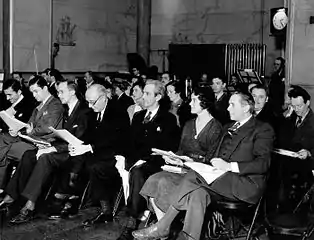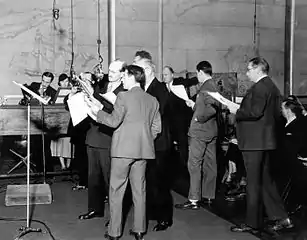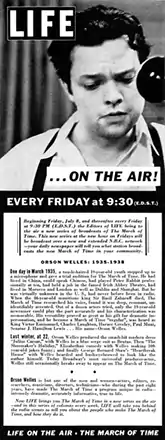The March of Time (radio program)
The March of Time is an American radio news documentary and dramatization series sponsored by Time Inc. and broadcast from 1931 to 1945. Created by broadcasting pioneer Fred Smith and Time magazine executive Roy E. Larsen, the program combined actual news events with reenactments. The "voice" of The March of Time was Westbrook Van Voorhis. The radio series was the basis of the famed March of Time newsreel series shown in movie theaters from 1935 to 1951.
 CBS sound effects chief Ora Daigle Nichols and George O'Donnell on The March of Time | |
| Genre | News documentary and dramatization |
|---|---|
| Running time |
|
| Country of origin | United States |
| Language(s) | English |
| Syndicates | |
| Created by | Roy E. Larsen Fred Smith |
| Directed by | Arthur Pryor Jr. Donald Stouffer Thomas Harrington William Spier Homer Fickett |
| Produced by | Arthur Pryor Jr. Donald Stouffer Thomas Harrington |
| Executive producer(s) | Davidson Taylor (for CBS)[1]:42 |
| Narrated by | Ted Husing Westbrook Van Voorhis Harry von Zell |
| Original release | March 6, 1931 – July 26, 1945 |
| Sponsored by | Time Inc. |
Production
The March of Time had its origins in a 1928 radio series developed at WLW in Cincinnati, Ohio, by radio pioneer Fred Smith, who obtained permission to use material from Time magazine in his broadcasts. Later, Smith and Roy E. Larsen, the first circulation manager for Time, developed Time magazine's own radio program, which they called Newscasting. That program evolved into The March of Time, the first network presentation of a dramatized "news" format. At Smith's suggestion, the program included the "10 best radio actors", an "announcer extraordinary", a "splendid orchestra" and a "clever director."[2]
"The March of Time was the first radio newsreel", wrote radio historian John Dunning, "dramatized news events, elaborately staged with sound effects and music, put together like a newspaper—often on deadline, with impact and accuracy its twin goals."[3]:435
The March of Time began airing as a weekly series March 6, 1931, on CBS Radio on over 32 stations on Friday evenings.[4] The half-hour program aired Fridays at 8:30 p.m. ET. In 1935 the program was trimmed to 15 minutes and aired five times a week,[5] but after a year returned to its 30-minute weekly format. Suspended in 1939, the series was revived in 1941 with a new format, and lasted until 1945.[6]:19
Time Inc. was the only sponsor of all of the shows; other sponsors included Remington Rand, the Wrigley Company, and Electrolux. The March of Time aired on CBS through October 7, 1937, and was subsequently broadcast on the Blue Network (October 14, 1937 – June 5, 1942), NBC (July 9, 1942 – October 26, 1944), and ABC (November 2, 1944 – July 26, 1945).[7]
One of radio's most popular programs, The March of Time was described by Variety as "the apex of radio showmanship." It reached millions of Americans during its 14-year history. The series's promotional value to Time Inc. proved to be incalculable, although Time had announced that it would discontinue the program after the first year.[6]:18–19 It was an expensive production requiring as many as 75 staff and 1,000 hours of labor to get each issue on the air.[6]:12–13
The full studio orchestra was conducted by Howard Barlow (CBS) and Donald Voorhees (NBC). The sound effects team was led by Ora Daigle Nichols, the only woman who made a living as a sound engineer at that time. She and her husband Arthur introduced sound effects to radio, drawing on many successful years of stage and silent film experience. They began to freelance their talents to radio in 1928, and were put under contract by CBS as the demand for sound effects increased. After her husband's death in 1931, Nichols continued to lead the profession and was called the "first lady of sound effects." The media voted Nichols one of the most influential women in radio; other women honored included Amelia Earhart, Eleanor Roosevelt and Kate Smith.[8]:16–17, 244
The March of Time broadcasts began with the tramp-tramp-tramp of shuffling feet, to indicate "the relentless impersonal progress of events." The principal narrator was the Voice of Time; another was the Voice of Fate, narrating stories of catastrophe or the death of a notable person. The first Voice of Time was Ted Husing; Westbrook Van Voorhis was the Voice of Fate. In fall 1931 Harry von Zell began a brief tenure as Time, but in October 1933 he moved to the role of announcer and Van Voorhis assumed the leading role. His voice—concluding most broadcasts with a booming, "Time … marches on!"—became synonymous with the program, both on radio and in the newsreel series.[3]:436–437
Written to match the style of Time magazine, radio scripts incorporated transcripts of statements and comments by the figures impersonated on The March of Time whenever possible. When these could not be obtained, writers were allowed to "re-create" appropriate dialogue. Actors researched and rehearsed with great care to mimic the precise voice patterns and characteristics of the people they were impersonating. March of Time creator Roy E. Larsen recalled that only one person, Franklin D. Roosevelt, ever complained about their treatment on the program. The President was annoyed because he was getting calls from political advisors regarding statements spoken on The March of Time that he had not uttered, even though they matched his policies. White House complaints continued until 1937, when The March of Time stopped imitating FDR altogether.[6]:14–15
"From the beginning it was known that The March of Time would face the stiffest production challenges that radio had yet known", wrote John Dunning:
When a big story broke at the last minute, a polished ready-to-air show was reorganized: the entire menu was shifted as events demanded. Newspapers are accustomed to this … but in radio, a new breed of actor had come to the fore, players who could deliver superb performances from scripts they had never seen before going live on the air. Sight reading, they called it: reading always two lines ahead and acting the lines they had already read. Actors, sound artists, and musicians worked feverishly to accommodate the bulletins from Time's reporters in the field.[3]:436
Seven or eight sketches were featured in each show, varying in length from 90 seconds to four minutes. Newspapers were sometimes scooped by the radio docudrama. On May 6, 1937, the Hindenburg disaster took place two hours before air time, and The March of Time created a segment that focused on the history of airship travel and ended with the news of the disaster in Lakehurst, New Jersey.[3]:436 Herbert Morrison's recorded radio eyewitness report from the landing field was not broadcast until the next day.[9]
 Sound effects specialists Ora D. Nichols, Henry Gauthiere, George O'Donnell, and Arthur Nichols on The March of Time[8]:16
Sound effects specialists Ora D. Nichols, Henry Gauthiere, George O'Donnell, and Arthur Nichols on The March of Time[8]:16 Rehearsal for The March of Time with cast including Ted de Corsia, William Pringle, William Adams, Marion Hopkinson and Ray Collins
Rehearsal for The March of Time with cast including Ted de Corsia, William Pringle, William Adams, Marion Hopkinson and Ray Collins Actors presenting The March of Time
Actors presenting The March of Time
Cast

Broadcast history
Unless noted, broadcast information for The March of Time is drawn from John Dunning's On the Air: The Encyclopedia of Old-Time Radio (1998).[3]:434
- 1931–35: CBS, March 6, 1931 – April 26, 1935, 30 minutes. Fridays at 10:30 p.m. ET March 6, 1931 – June 1931; Fridays at 8 p.m. July 1931–33; Fridays at 8:30 p.m. 1933–34; Fridays at 9 p.m. 1934–35.
- 1935–36: CBS, August 26, 1935 – September 25, 1936, 15 minutes. Weeknights at 10:30 p.m. ET.
- 1936–37: CBS, October 15, 1936 – October 7, 1937, 30 minutes. Thursdays at 10:30 p.m. ET.
- 1937–39: Blue Network, October 14, 1937 – April 28, 1939, 30 minutes. Thursdays at 8:30 p.m. ET October 14, 1938 – January 1938; Thursdays at 8 p.m. January–July 1938; Fridays at 9:30 p.m. July 8, 1938[12]– April 28, 1939.
- 1941–42: Blue Network, October 9, 1941 – June 5, 1942, 30 minutes. Thursdays at 8 p.m. ET October 9, 1941 – February 1942; subsequently Fridays at 9:30 p.m. or 9 p.m.
- 1942–44: NBC, July 9, 1942 – October 26, 1944, 30 minutes. Thursdays at 10:30 p.m. ET.
- 1944–45: ABC, November 2, 1944 – July 26, 1945, 30 minutes. Thursdays at 10:30 p.m. ET.
Reviews and commentary
- Orson Welles, This is Orson Welles — It was a marvelous show to do. Great fun, because, half an hour after something happened, we'd be acting it out with music and sound effects and actors. It was a super show — terribly entertaining. ... I began as an occasional performer, because they had a regular stock company, and then I was finally let in—one of the inner circle. And then I had the greatest thrill of my life—I don't know why it thrilled me (it does still, to think of it now), I guess because I thought March of Time was such a great thing to be on. One day, they did as a news item on March of Time the opening of my production of the black Macbeth, and I played myself on it. And that to me was the apotheosis of my career—that I was on March of Time acting and as a news item. I've never felt since that I've had it made as much as I did that one afternoon.[11]:74
- John Dunning, On the Air: The Encyclopedia of Old-Time Radio — And like any good newspaper, it was damned left and right. Real newsmen condemned it for hamming up the news. Communists called it fascistic. William Randolph Hearst labeled it Communistic propaganda and forbade mention of it in the pages of his newspapers. It was banned in Germany, It even ran afoul of Roosevelt, who asked and later demanded that it stop impersonating him, because the actors were so good they were diminishing the impact of his Fireside Chats. It was accused of being pompous, pretentious, melodramatic, and bombastic. But it was never dull. In the mid-1930s, Time had Hooper numbers in the 25 point range.[3]:436
Awards and recognition
The March of Time was inducted into the National Radio Hall of Fame in 1990.[13]
References
- Carskadon, Tom (January 1935). "Time Marches On". Tower Radio. Internet Archive. Archived from the original on January 2, 2013. Retrieved 2016-03-01.
- "Fred Smith, Radio Pioneer, Dies; Helped Create 'March of Time'". The New York Times. August 15, 1976.
- Dunning, John (1998). On the Air: The Encyclopedia of Old-Time Radio (Revised ed.). New York, NY: Oxford University Press. pp. 434–437. ISBN 978-0-19-507678-3. Retrieved 2019-08-31.
The March of Time,news.
- "The March of Time—Series Premiere". Paley Center for Media. Retrieved 2016-03-01.
- "Catalog Record, The March of Time (Radio Program)". New York Public Library. Retrieved 2016-03-01.
- Fielding, Raymond (1978). The March of Time, 1935–1951. New York: Oxford University Press. ISBN 0-19-502212-2.
- Hickerson, Jay (1992). The Ultimate History of Network Radio Programming and Guide to All Circulating Shows. Hamden, Connecticut: Privately printed. pp. 252–253.
- Mott, Robert L. (1993). Radio Sound Effects: Who Did It, and How, in the Era of Live Broadcasting. Jefferson, North Carolina: McFarland & Company. ISBN 9780899507477.
- "WLS Broadcast of the Hindenberg Disaster 1937". Chicagoland Radio and Media. Retrieved 2016-03-02.
- "Howard Smith, 73, An Actor, Is Dead; Performed for 50 Years in Vaudeville and on Air". The New York Times. January 11, 1968. Retrieved 2016-03-01.
- Welles, Orson; Bogdanovich, Peter; Rosenbaum, Jonathan (1992). This is Orson Welles. New York: HarperCollins Publishers. ISBN 0-06-016616-9.
- "Life … On the Air!". Life. July 11, 1938. p. 65. Retrieved 2016-03-01.
- The March of Time at the National Radio Hall of Fame; retrieved April 8, 2012
External links
| Wikimedia Commons has media related to The March of Time (radio program). |
- The March of Time at the National Radio Hall of Fame
- The March of Time at RadioGOLDINdex
- Finding Aid (PDF), The March of Time (Radio Program), New York Public Library
Radio broadcasts at the Internet Archive
- 1930–1937 Radio News — includes The March of Time from January 18, 1937
- 1938 Radio News — includes The March of Time from February 3 and February 10, 1938
- 1940 Radio News — includes The March of Time from August 24, 1940
- 1941 Radio News — includes The March of Time from November 20 and December 11, 1941
- 1945 Radio News — includes The March of Time from February 22, March 15, March 22, March 29 and April 5, 1945